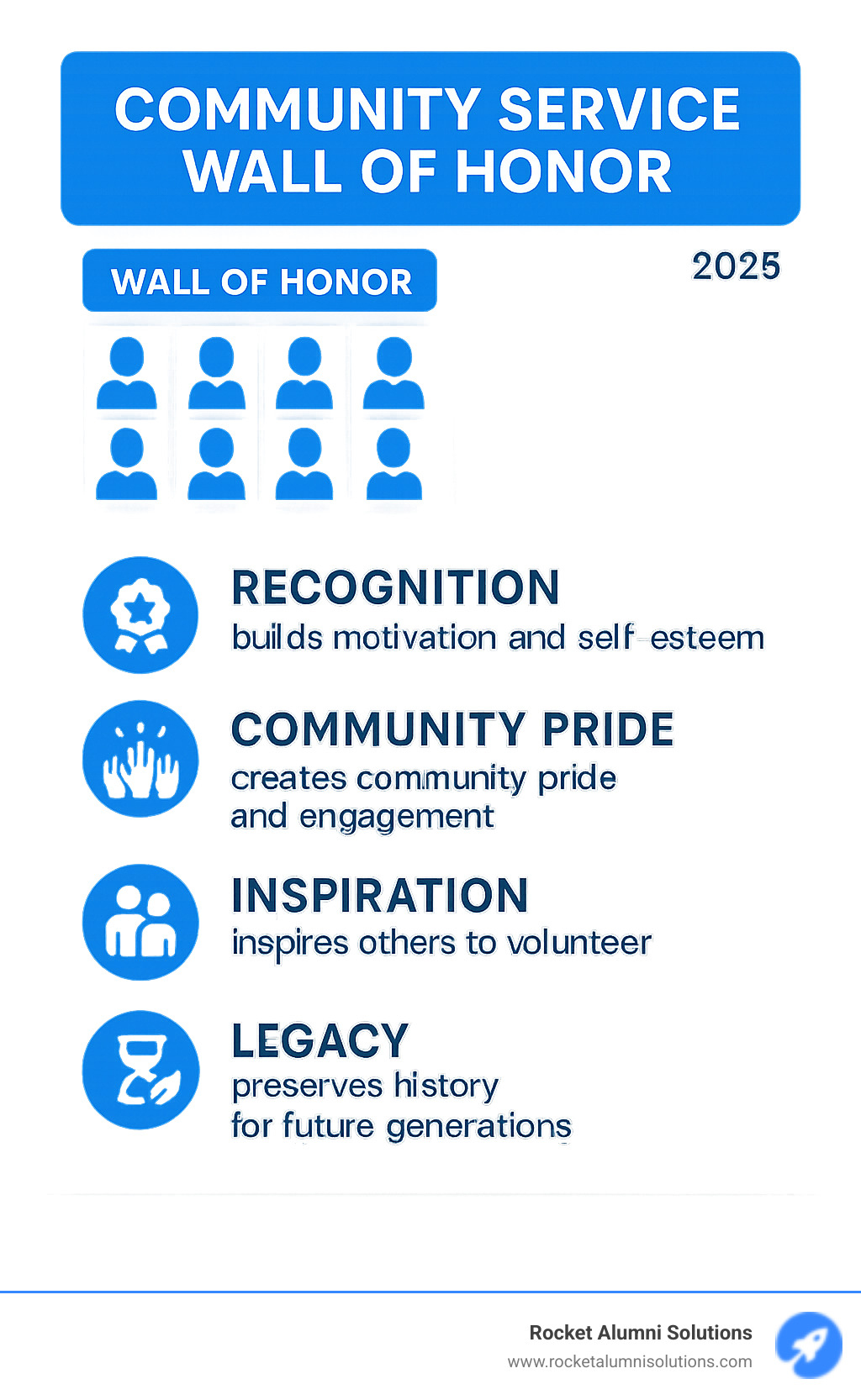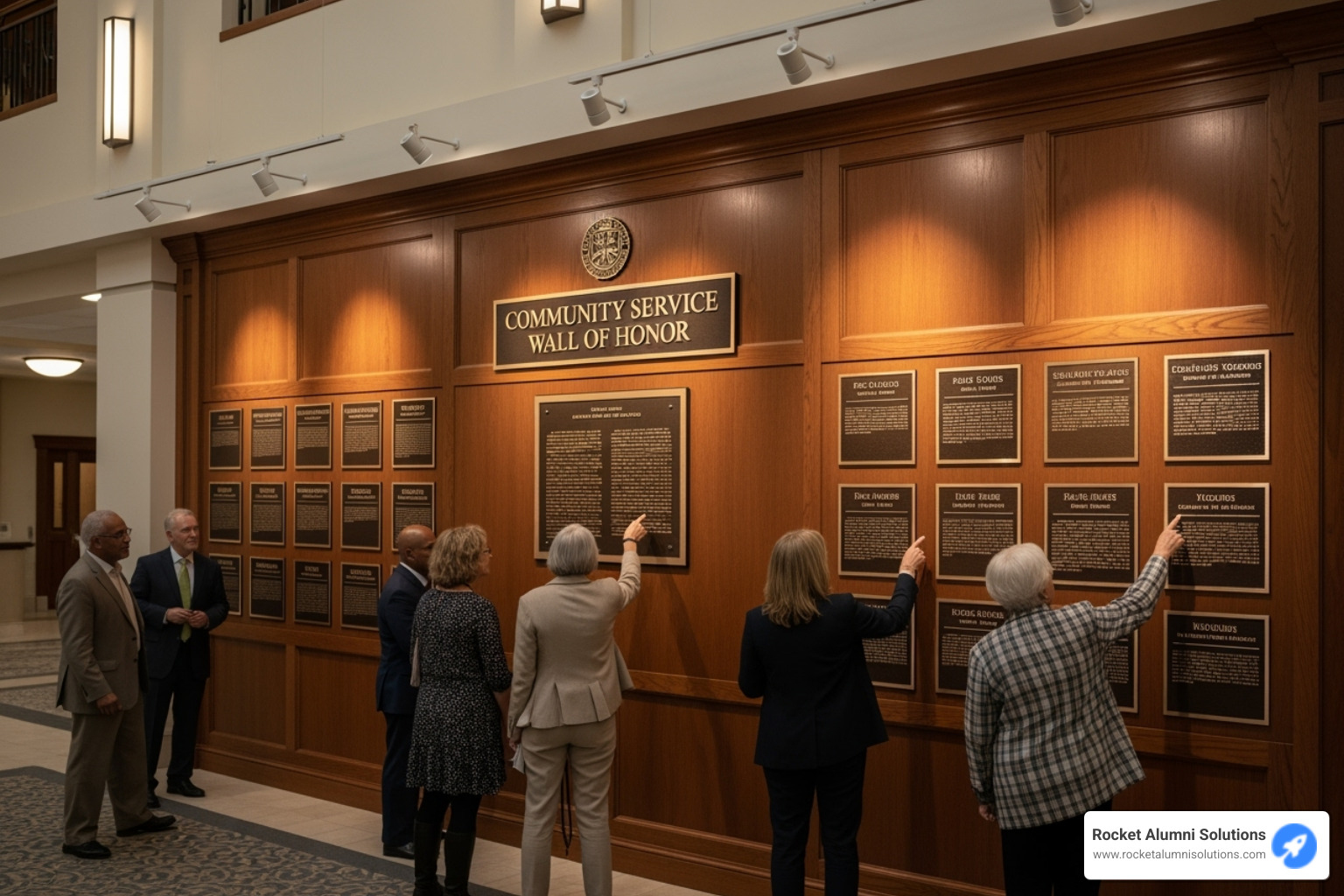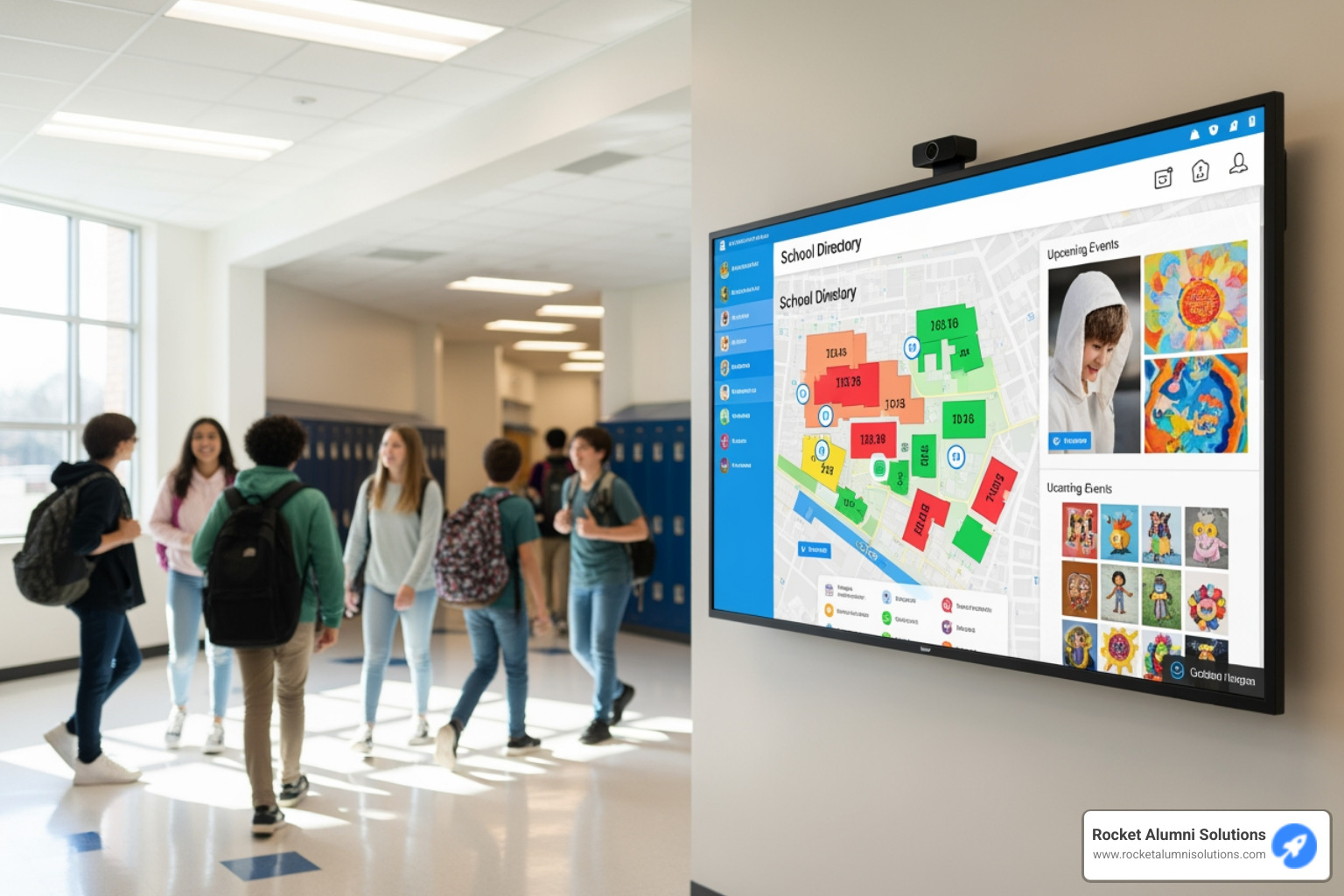What is a Community Service Wall of Honor and Why Does It Matter?
A Community Service Wall of Honor is a dedicated display that recognizes individuals who have made significant contributions through volunteer work, military service, or other acts of community service. These walls serve multiple purposes:
- Recognition: Honor volunteers, veterans, first responders, and community leaders
- Inspiration: Motivate others to get involved in community service
- Legacy: Preserve stories of service and sacrifice for future generations
- Community Building: Foster pride and strengthen bonds within the community
The concept has evolved from simple memorial plaques to sophisticated digital displays. As noted in research from The Wall of Honor organization in North Dakota, these tributes now feature "over 100 digital displays across the state, featuring their photo, name, and service details." This modern approach allows for unlimited honorees and easy updates.
Whether honoring fallen service members like the Secret Service's Wall of Honor or celebrating living volunteers like Somerset County's military recognition wall, these displays create what one expert calls "happy nostalgia" - a powerful connection between past service and future engagement.
The impact extends beyond simple recognition. Community service recognition creates a ripple effect - inspiring others to volunteer, building stronger community bonds, and validating the efforts of those who give their time selflessly. From high school students tracking volunteer hours to veterans being honored for their sacrifice, these walls represent the values a community holds dear.
I'm Chase McKee, Founder and CEO of Rocket Alumni Solutions, where I've helped hundreds of organizations modernize their recognition programs through interactive touchscreen displays. Through our work creating digital Community Service Wall of Honor displays, I've seen how effective recognition can increase donor engagement by over 25% and dramatically boost community participation.

Important Community Service Wall of Honor terms:
When you walk past a Community Service Wall of Honor, you're witnessing something powerful in action. These displays don't just sit there looking pretty – they actively transform both the people they honor and the communities that see them every day.
Think about what happens when someone receives recognition for their volunteer work. Suddenly, all those hours spent helping at the food bank or coaching youth sports feel truly valued. Recognition creates motivation – when people know their efforts matter, they're inspired to keep giving back. It's like fuel for the volunteer spirit.
The boost to self-esteem is equally important. Having your name on a wall or receiving a certificate validates all that hard work. For students, this documented service history can open doors to college scholarships and job opportunities. Employers love seeing candidates who've shown commitment to their communities.
But here's where it gets really interesting – the impact spreads far beyond the honorees themselves.
Community pride grows when neighbors see their friends and family members being celebrated. These walls become a source of collective identity, showing everyone what the community values most. When kids walk by and see local heroes honored, they start thinking, "Maybe I could do something important too."
The role modeling effect is incredible to watch. Young people especially get inspired when they see peers being recognized. It creates what researchers call "happy nostalgia" – positive memories that connect past service with future possibilities.
Recognition also strengthens community bonds in unexpected ways. People feel more connected when they're part of something bigger than themselves. They see their neighbors' contributions and realize they're all working toward shared goals.
Here's what makes recognition so powerful for building stronger communities:
It validates every contribution – showing that whether you donated time at the animal shelter or organized a neighborhood cleanup, your efforts count. It inspires others to get involved by making service visible and celebrated. It reinforces shared values like compassion and civic duty that hold communities together. It connects different generations through stories of service that span decades. It creates positive momentum where giving back becomes the cool thing to do.
Building Community Pride and Engagement
A Community Service Wall of Honor becomes the heart of a community's story. It's where individual acts of kindness transform into a shared legacy that everyone can be proud of.
When people see their neighbors publicly appreciated, something magical happens. The wall showcases what the community stands for – service, sacrifice, and looking out for each other. These values become visible and real, not just words in a mission statement.
Take Somerset County's approach, which "salutes all Somerset County residents currently serving in the U.S. military." By honoring local service members, they've created a visible connection between their community and those who serve. Families feel proud, young people get inspired, and everyone understands that service matters here.
The ripple effect is remarkable. When one person gets recognized, their friends start thinking about volunteering too. Parents point out honorees to their children during school events. Retirees see their peers celebrated and decide to get involved in community projects.
North Dakota's Wall of Honor, with its "over 100 digital displays across the state," shows how recognition can inspire engagement on a massive scale. The emotional connections people feel when seeing loved ones honored creates deep community pride that lasts for generations.
Motivating Individuals and Recognizing Sacrifice
Being recognized on a Community Service Wall of Honor does something powerful – it transforms abstract good deeds into concrete acknowledgment. That volunteer work suddenly feels more significant when the whole community can see it.
Validating effort through recognition keeps people motivated to continue serving. It's human nature to want appreciation for hard work, and these walls provide exactly that kind of meaningful thanks.
Some walls honor the ultimate sacrifice. The Secret Service's Wall of Honor, dedicated in December 2000, remembers colleagues who "died in the line of duty," including Special Agent George P. LaBarge and Special Agent Daniel M. Connolly. These memorials create lasting connections between past sacrifice and present service.
Veterans deserve special recognition for their commitment to our country. The Returning Veterans Project's Wall of Honor lets the public "honor a Veteran or Service Member," connecting community gratitude with ongoing support for those who served.
First responders also find their place on these walls. The Toronto Police Service's Honour Wall commemorates members who died "as a result of their service," organizing them by conflicts and circumstances. These tributes remind everyone of the daily risks these heroes accept to keep communities safe.
The U.S. Coast Guard Academy's Hall of Heroes and Wall of Gallantry recognize "courage and sacrifices of Academy alumni," celebrating heroic service in dangerous situations. These displays don't just remember the past – they inspire future generations to uphold the same values of duty and honor.
When communities take time to honor both everyday volunteers and extraordinary heroes, they send a clear message: service matters, sacrifice is remembered, and everyone's contribution counts.
Establishing Your Wall: Honorees, Criteria, and Nominations

Creating a successful Community Service Wall of Honor starts with three fundamental decisions: who deserves recognition, what standards they must meet, and how people can nominate them. Getting these elements right from the beginning ensures your wall will be fair, meaningful, and respected by your entire community.
The beauty of a Community Service Wall of Honor lies in its flexibility. You can cast a wide net to celebrate all forms of service, or focus on specific groups that matter most to your organization. Either approach works beautifully when done thoughtfully.
Who Is Typically Honored?
The heart of any Community Service Wall of Honor beats with the stories of people who put others first. Volunteers often form the backbone of these displays, especially those who've dedicated countless hours to local charities, environmental causes, or community events. High schools like Blind Brook High School and North Shore High School have finded that tracking and celebrating student volunteer hours creates a culture where giving back becomes the norm rather than the exception.
Alumni hold a special place on many walls, particularly in educational settings. Bishop Brady High School created an "Alumni Veterans Wall of Honor" specifically to recognize graduates who served their country. The U.S. Coast Guard Academy takes this further, honoring alumni who showed extraordinary heroism in dangerous situations.
Military veterans and active service members represent perhaps the most common category of honorees. Somerset County's Wall of Honor salutes residents currently serving in the U.S. military, creating a visible bridge between the community and those protecting it. The North Dakota Wall of Honor has grown to include over 100 digital displays across the state, each featuring photos, names, and service details of local heroes.
First responders deserve equal recognition for their daily courage. Police officers, firefighters, paramedics, and other emergency personnel risk their lives to keep communities safe. The North Dakota Wall of Honor wisely includes first responders alongside military personnel, recognizing that heroism comes in many uniforms.
Community leaders and philanthropists often drive positive change through leadership and generous giving. These individuals shape the character of their communities through sustained commitment and vision. Finally, posthumous honorees ensure that those who made the ultimate sacrifice are never forgotten. The Secret Service's Wall of Honor, dedicated in December 2000, remembers colleagues like Special Agent George P. LaBarge and Special Agent Daniel M. Connolly who died in the line of duty.
Defining Clear Criteria and a Fair Nomination Process
Establishing clear, consistent criteria protects the integrity of your Community Service Wall of Honor while ensuring everyone understands what qualifies someone for recognition. The key is matching your criteria to the type of service you want to celebrate.
For volunteer service, you might require a minimum number of service hours—perhaps 100 or more—along with demonstrated community impact. The duration of someone's commitment often matters more than short-term involvement, showing sustained dedication to a cause.
Military and first responder service typically requires honorable discharge or active duty status. Some walls focus on specific acts of bravery, like the U.S. Coast Guard Academy's "Wall of Gallantry" which recognizes "significant acts of heroic service." Others honor those who died in service, like the Toronto Police Service's Honour Wall, which requires Chief of Police approval for names to be engraved.
Geographic connections often matter too. North Dakota's wall includes people "born in ND, once lived/currently live in ND, or were stationed/served in ND," while Somerset County focuses on county residents. This local connection helps communities feel ownership of their wall.
The nomination process should welcome community participation while maintaining high standards. Clear nomination forms—whether digital or paper—should request complete information including the honoree's name, service details, dates, and supporting materials like photos or testimonials. The Rancho Bernardo Museum's Wall of Honor requires both a downloadable form and photo submission, making expectations crystal clear.
Public submissions create community ownership of the process. The North Dakota Wall of Honor encourages a $50 donation per honoree but explicitly states "no donation is required to submit," ensuring money never becomes a barrier to recognition.
A fair selection committee reviews nominations against your established criteria. This group ensures eligibility requirements are met and maintains consistent standards. The Toronto Police Service demonstrates transparency by requiring Chief of Police approval and providing clear links to their "Honour Wall Procedure" and application.
Transparency builds trust in your process. Somerset County provides easy access for "photo submissions, updates and deletions," showing their wall remains current and accessible. When people understand how decisions are made, they're more likely to support and participate in your recognition program.
The most successful walls balance accessibility with standards, making it easy for people to nominate deserving individuals while maintaining the dignity and meaning that makes recognition special.
Designing Your Tribute: From Physical Plaques to Interactive Displays

Once you've figured out who to honor and how they'll be selected, the fun part begins - designing your Community Service Wall of Honor! This is where your vision comes to life, and honestly, the options today are pretty amazing compared to what we had even a decade ago.
The world of recognition displays has changed dramatically. We've moved from simple bronze plaques that took weeks to engrave to digital displays that can be updated instantly from your phone. Both approaches have their place, and your choice really depends on your budget, available space, and how you envision people interacting with your wall.
Traditional Wall of Honor Displays
There's something timeless about walking up to a physical memorial and running your fingers over engraved names. Traditional displays have been honoring heroes for centuries, and they still pack an emotional punch.
Engraved plaques and bronze nameplates create that sense of permanence that digital just can't match. When the Secret Service dedicated their Wall of Honor in 2000, they chose a physical memorial for good reason - it feels weighty and important. Framed photos and memorial walls take this a step further, putting faces to names and creating personal connections.
Bishop Brady High School's Alumni Veterans Wall of Honor is a perfect example of traditional done right. Their 6' by 10' physical wall lists alumni veterans from 1934 to today, with names arranged on flag stripes and POWs honored in the stars. It's beautiful, respectful, and creates a powerful visual impact.
The permanence of traditional displays is their biggest strength. These installations can last decades with minimal maintenance, and there's something special about the tangible experience they provide. Visitors can touch the wall, leave flowers, or simply stand quietly in reflection.
But let's be honest about the challenges. Cost of updates can be brutal - adding even one new name might mean ordering a new plaque and hiring someone to install it. Limited space becomes a real problem as your wall grows, and you're stuck with a static experience that can't tell the full story of each person's service.
The Modern Community Service Wall of Honor: Digital and Interactive Displays
Digital displays have completely changed what's possible with recognition walls. Instead of being limited to names and maybe a photo, you can now create rich, interactive experiences that bring each person's story to life.
Touchscreen kiosks and digital signage let visitors explore at their own pace, diving deep into the stories that interest them most. The North Dakota Wall of Honor uses over 100 digital displays across the state, each featuring photos, names, and detailed service information. That's the kind of scale that would be impossible with traditional plaques.
Online walls and interactive timelines break down geographical barriers completely. Your Community Service Wall of Honor can reach family members across the country, alumni living overseas, or anyone who wants to learn about your community's heroes. Video bios and searchable databases turn simple recognition into powerful storytelling, letting you share not just what someone did, but who they were as a person.
The practical benefits are huge too. Easy updates mean adding a new honoree takes minutes instead of weeks. Unlimited space means you never have to worry about running out of room. ADA compliance ensures everyone can access and enjoy the display, with features like adjustable text size and audio narration.
At Rocket Alumni Solutions, we've seen how social media integration and mobile accessibility can amplify your recognition efforts. When visitors can easily share honoree stories on their phones, your wall's impact extends far beyond its physical location. Our interactive displays transform traditional recognition into engaging experiences that help build stronger community connections and encourage ongoing involvement.
The beauty of modern digital solutions is their flexibility. You can showcase unlimited honorees with photos, videos, and detailed stories - all managed through a simple, cloud-based system that anyone can learn to use.
How to Launch Your Own Wall of Honor Initiative

Starting your own Community Service Wall of Honor might feel overwhelming at first, but it's one of the most rewarding projects you can undertake for your community. I've helped dozens of organizations through this process, and the joy on people's faces when they see their heroes recognized makes every step worthwhile.
The key is breaking it down into manageable pieces and building momentum as you go. Think of it like planning a big family reunion - you need the right people, a clear plan, and enough resources to make it memorable.
A Step-by-Step Guide to Getting Started
Forming a committee is your foundation. You'll want passionate people who represent different parts of your community - maybe a veteran, a school administrator, a local business owner, and some dedicated volunteers. The North Shore High School found success with their Community Services Coordinator leading the charge, giving the project a dedicated champion.
Defining your mission and criteria comes next, and this is where things get exciting. What story do you want your wall to tell? Are you honoring all types of community service, or focusing on specific groups like veterans or volunteers? The Toronto Police Service created their "Honour Wall Procedure" with crystal-clear guidelines, which saved them countless headaches later.
Securing funding doesn't have to break the bank. The North Dakota Wall of Honor suggests a $50 donation per honoree but makes it clear that no donation is required. Bishop Brady High School took over two years to raise funds for their Veterans Wall of Honor, but they made it happen through persistence and community support.
Choosing your format is where the fun really begins. Will you go traditional with bronze plaques, or accept the digital age with interactive displays? Maybe a hybrid approach works best for your space and budget. Consider how you'll handle updates - digital solutions make adding new honorees as easy as uploading a photo.
Designing the display should reflect your community's personality. Bishop Brady chose a beautiful flag motif for their veteran's wall, while others prefer clean, modern layouts. If you're going digital, think about features like search functions and mobile access that make the experience engaging for visitors of all ages.
Promoting the initiative is crucial for getting those nominations rolling. The North Dakota Wall of Honor's simple "Submit your hero Now!" call-to-action shows how direct communication works best. Use every channel you have - local newspapers, social media, community bulletin boards, and word of mouth.
Planning an showing ceremony gives your project the grand finale it deserves. Bishop Brady High School chose November 10th for their Veterans Recognition Wall showing, while the U.S. Coast Guard Academy holds annual induction ceremonies. These events bring the community together and create lasting memories for honorees and their families.
Don't underestimate the power of a beautifully designed certificate. While your Community Service Wall of Honor provides public recognition, certificates give honorees something personal to treasure.
These aren't just pieces of paper - they're tangible proof of someone's dedication that can sit on a desk, hang in a home office, or be included in a college application. They formalize the honor in a way that feels official and meaningful.
Customization options make each certificate special. Add your organization's logo, include specific details about the person's service, or incorporate design elements that match your wall's aesthetic. Whether you create digital certificates for easy sharing or printable versions for framing, you're giving honorees a personal keepsake that complements their public recognition.
The beauty of combining a wall with certificates is that you're covering all the bases - public celebration and private appreciation. It's like giving someone both a spotlight moment and a personal thank-you note, and both matter more than you might think.
Frequently Asked Questions about Walls of Honor
When we work with schools and organizations to create their recognition programs, certain questions come up again and again. Let me share the answers to help you make the best decisions for your community.
What is the difference between a Wall of Honor and a Hall of Fame?
This is one of the most common questions we hear, and it's a great one because the distinction matters when you're planning your recognition program.
A Community Service Wall of Honor celebrates service, sacrifice, and contributions to the community. Think about the Secret Service's Wall of Honor remembering fallen agents, or Somerset County's tribute to their military personnel. These walls honor people who gave their time, energy, or even their lives for others.
A Hall of Fame is different - it's all about excellence and achievement in specific areas like sports, academics, or professional accomplishments. When a school wants to showcase their championship teams or top academic performers, that's Hall of Fame territory.
The heart of the difference? A Wall of Honor says "thank you for serving others," while a Hall of Fame says "congratulations on your outstanding performance." Both are important, but they serve different purposes in building community pride.
How much does it cost to create a Wall of Honor?
The honest answer? It depends on what you're envisioning, but let me break it down so you can plan accordingly.
Physical displays can range from a few hundred dollars for a simple plaque to several thousand for an elaborate wall installation. The challenge comes with updates - every time you want to add someone new, you're looking at additional engraving and installation costs.
Digital solutions require a higher upfront investment for the hardware and software, but here's where they become incredibly cost-effective. You get unlimited space for honorees, instant updates that you can make yourself, and the ability to include photos, videos, and detailed stories without any additional physical space.
Take the North Dakota Wall of Honor as an example - they suggest a $50 donation per honoree to help maintain their digital network, but submissions are completely free. That's the beauty of digital: once it's set up, adding new people doesn't require expensive physical changes.
When we help organizations make this decision, we always consider their long-term vision. If you're planning to honor dozens or hundreds of people over the years, digital quickly becomes the smarter financial choice.
Can a Wall of Honor be entirely virtual or online?
Absolutely, and it's often the best choice for many organizations! A virtual Community Service Wall of Honor opens up possibilities that physical walls simply can't match.
Here's what makes online walls so powerful: unlimited space means you never have to choose between honorees due to physical constraints. Your alumni living across the country can visit anytime, from anywhere, using any device. Family members can easily share their loved one's recognition on social media, spreading the impact far beyond your local community.
The interactive features are where virtual walls really shine. Visitors can search for specific names, watch video tributes, and explore detailed biographies that would be impossible to display on a physical wall. Updates happen instantly - no waiting for new plaques or dealing with installation schedules.
We've seen how virtual walls create connections that physical displays can't. When a veteran's family in another state can show their grandchildren their grandfather's service record online, or when a former volunteer can share their recognition with friends on Facebook, the impact multiplies exponentially.
The accessibility factor is huge too. Everyone can interact with your Wall of Honor regardless of their physical abilities or location, making recognition truly inclusive and far-reaching.
A Community Service Wall of Honor represents so much more than names on a wall or faces on a screen. It's a living celebration of the human spirit - a testament to the countless individuals who choose to put community before self, service before comfort, and giving before receiving.
Throughout this guide, we've seen how these meaningful displays transform both individuals and entire communities. When we recognize student volunteers tracking their service hours, honor military veterans who've sacrificed for our freedom, or celebrate first responders who risk their lives daily, we're doing something profound. We're saying their efforts matter.
The ripple effects are remarkable. A single Wall of Honor can boost community pride, strengthen the bonds between neighbors, and inspire a whole new generation to roll up their sleeves and get involved. It creates what researchers call "happy nostalgia" - that warm feeling of connection between past service and future possibilities.
Recognition has real power. It validates the late nights spent volunteering at the food bank, the years of military service far from home, and the countless small acts of kindness that make communities thrive. When people feel seen and appreciated, they don't just continue serving - they inspire others to join them.
Whether you choose a traditional bronze plaque wall or accept modern digital technology, you're creating a lasting tribute that will encourage future service for generations. The stories preserved today become the inspiration for tomorrow's volunteers, veterans, and community leaders.
At Rocket Alumni Solutions, we've had the privilege of helping hundreds of organizations modernize their recognition programs. We've seen how interactive digital displays can increase community engagement and bring recognition programs into the 21st century. Our customizable solutions make it easy to honor unlimited individuals with rich photos, videos, and stories that can be shared across social media and accessed from anywhere in the world.
Ready to start building your own legacy of community engagement? Explore digital Wall of Honor solutions from Rocket Alumni Solutions and find how we can help you create something truly special for your community.



















































































































































































































































































































